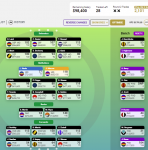Interesting, everyone using hand picked examples to say you should never trade to a mid pricer with early season form. On percentages, this obviously works due to players have spike games.
However, this strategy means you effectively forgoes any breakout players for the season, even if they end up D2 or F2?
Last year you would have 100% ignored Maynard and Ridley in your backline, I think the best coaches will be a little bit more nuanced in their decision making when it comes to early season form. Every player has spike games, so can't be seduced by those, however improved role and responsibility can be a great sign for an improved season. I refused to pick Jack Steele due to the "mid pricer" rule last year, and it consistently cost me!
However, this strategy means you effectively forgoes any breakout players for the season, even if they end up D2 or F2?
Last year you would have 100% ignored Maynard and Ridley in your backline, I think the best coaches will be a little bit more nuanced in their decision making when it comes to early season form. Every player has spike games, so can't be seduced by those, however improved role and responsibility can be a great sign for an improved season. I refused to pick Jack Steele due to the "mid pricer" rule last year, and it consistently cost me!
Bringing in one after two good scores is incredibly risky and backfires more often than not.
Bringing in one after three or four good scores is about where I think sensible SC coaches target. The player would have gained a bit of cash but there's still plenty of growth, so you're still getting value and the risk is greatly reduced.
That's if we're talking someone in the $300k-400k range... Obviously the lower the player's price is the lower the risk is anyway, so if the player is barely above rookie price, e.g. $250k, I have a lot fewer issues with bringing them in at the two game mark since the initial jump is going to be higher, you're not investing as much, and can effectively treat them as a cashcow if they do backfire.


